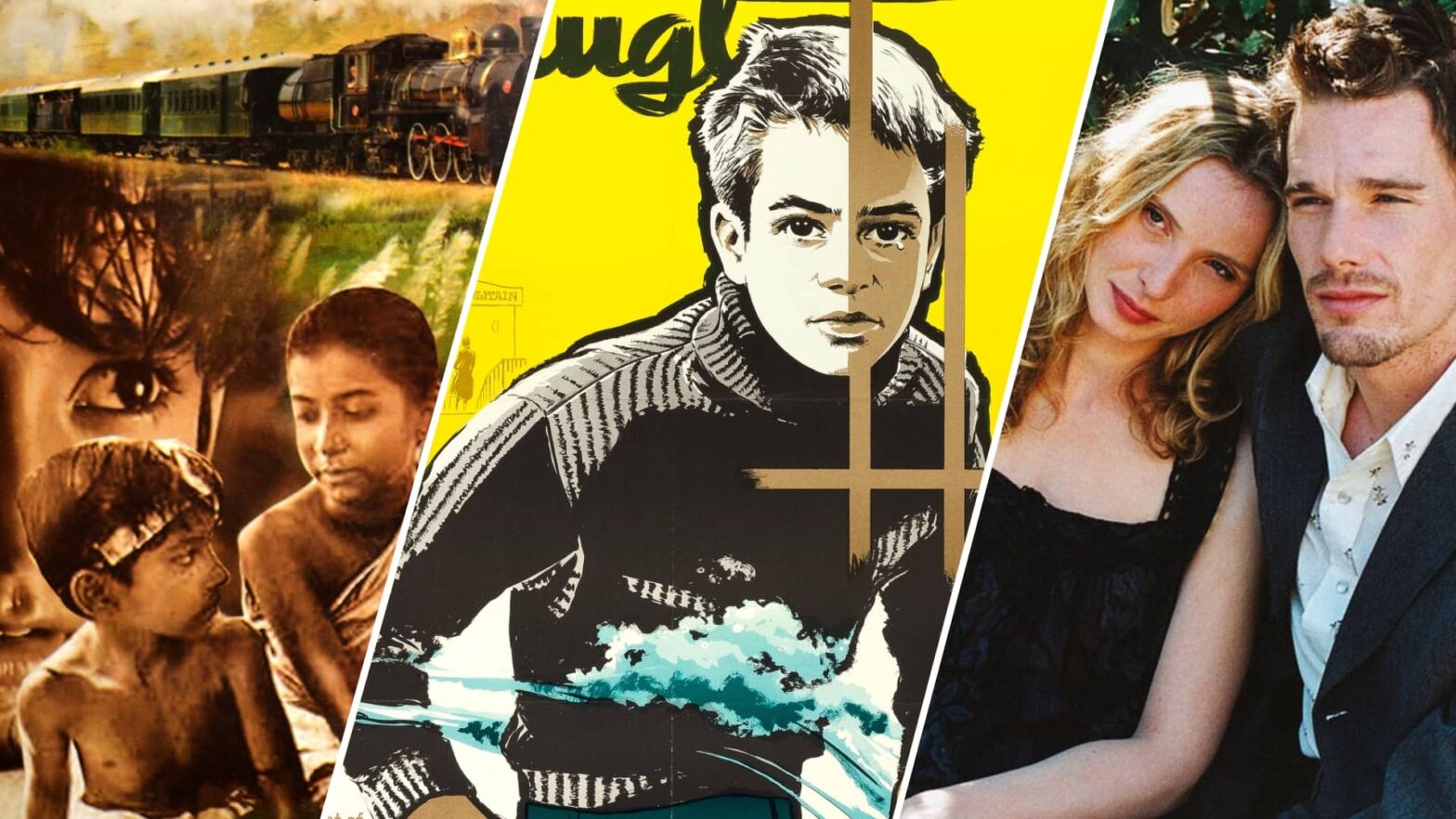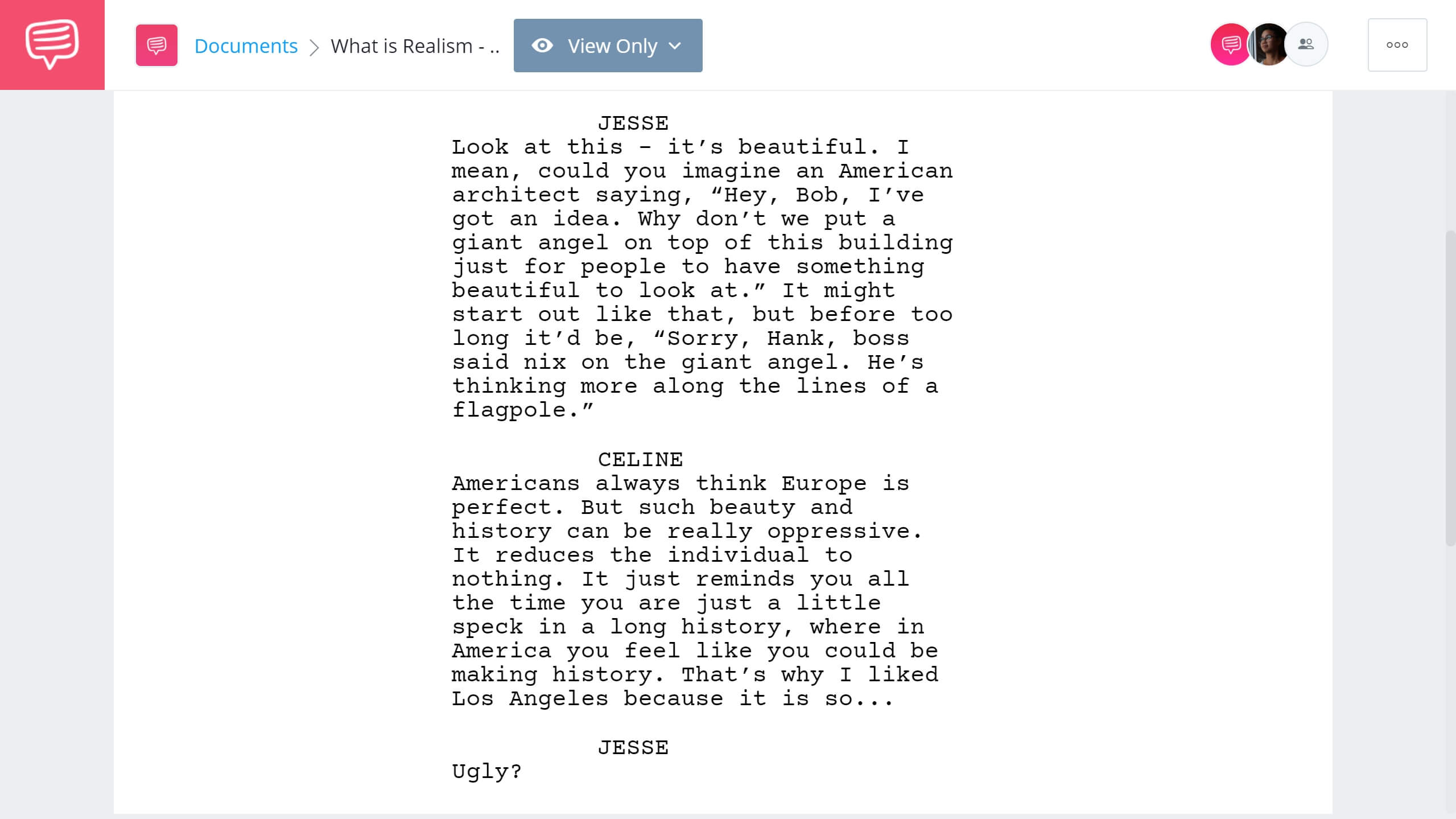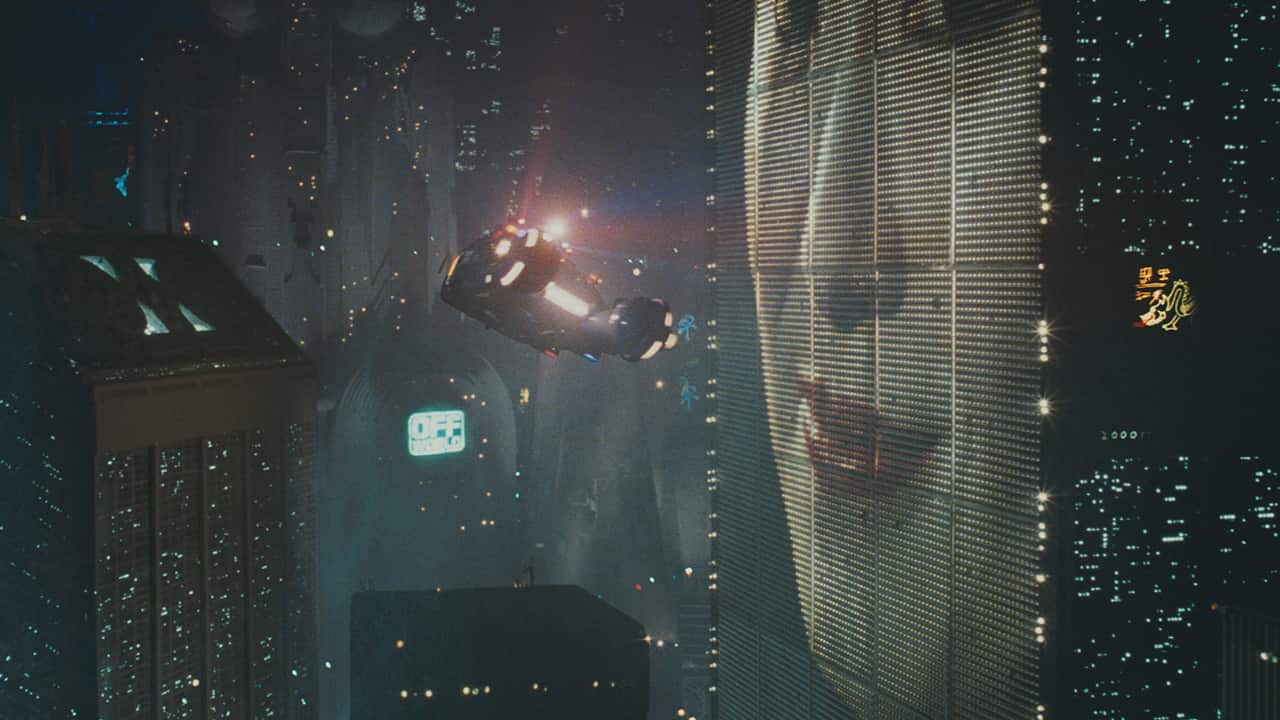What is realism in film? We hear the term “realistic” all the time, but how do we know if something is realistic when realism is so subjective? Well, in storytelling, there is an objective way to tell whether or not something is realistic. We’re going to explore what realism is and how it’s used in film, with examples from Pather Panchali, the Before Trilogy, and more, but first let’s review where realism began.
AESTHETIC REALISM IN FILM DEFINITION
What is realism in film?
Realism in film is a cinema subcategory that many refer to as “slice of life.” Cinematic realism is rooted in the tenets of the realism arts movement, as well as philosophical realism. We can infer whether or not a film is “realistic” based on objective truths, like if it has unsensational happenings, or contained narratives. Realism is used in film to create intimate stories that connect the audience in some sort of introspective way.
Realism in Film Movements
- Italian Neorealism
- Cinema Verite
- Indie Walk and Talks
Definition of Realism in Film
Realism is a reflection
In simplest terms, realism is a reflection of the world around us. Some artists and philosophers don’t believe that there is an objective “reality.” But for the sake of focus, let’s say there is a reality, and that the words you’re reading are words that I’ve written. They’re real, you’re real, I’m real — as Descartes said, “I think, therefore I am.” Okay, we’re on the same page.
Realism began as an arts movement in the 19th century. That’s not to say that there wasn’t realistic art before the 19th century though — quite the contrary. Statues in Ancient Greece were regarded as “real” for their anatomical precision. But realism really took off in mid 19th century France.
At that time, paintings were the number one medium for “realism.” This video explains the history of realism in art, and makes a case for its use.
Aesthetic Realism in Film • The Case for Realism by The Art Assignment
As the video explains, realism is all about depicting life as it’s presented to us. It’s about taking what we infer reality to be and transposing or transcribing it onto an artistic medium, either in writing, photography, film, etc.
Realism in film relies on both narrative and visual realism — by this I mean that the story must be grounded in reality and the visuals must match. These movies are grounded in reality with none of the escapist fantasy of the typical Hollywood blockbuster.
The Rebirth of Cinematic Realism
Neorealism in film
Location shooting is one of the predominant characteristics of realism in film. Between World War I and World War II, most movies were shot in studios. There were some movies that were shot in part, or mostly on location, like Sergei Eisenstein’s Soviet Montage film Battleship Potemkin, but most were shot in sound stages or on sets.
French filmmaker Jean Renoir is widely credited as The Godfather of realism in film, even though most of his films were shot on set. His late 1930s films La Grande Illusion and The Rules of the Game were major catalysts for introducing realism in film.
World War II incited filmmakers from around the globe to take to the streets to make their films. Some films from this period, like Roberto Rossellini’s Rome, Open City, birthed cinematic movements such as Italian neorealism. Other filmmakers who helped to define Italian neorealism were Vittorio De Sica, Luchino Visconti, and Giuseppe De Santis. This next video explains how Italian neorealism helped to change the course of cinema.
What is Realism in Film? • How Italian Neorealism Shows You the World
The term neorealism, translated from the Italian neorealismo, quite literally means “new reality.” The new reality that neorealism refers to is the reality of the world in the wake of World-War II. But in many ways, Italian neorealism is where realism in film began. Many more characteristics of realism in film, like the use of amateur actors, low budget production costs, and narratives based on contemporary events sprouted with Italian neorealism.
By the late 1950s, “realism in film” had spread to other areas of the world; like India with Satyajit Ray’s Apu Trilogy, and France with Francois Truffaut’s The 400 Blows. These films were structured in the same way, with realistic settings, relatable characters, and relevant narratives.
For many filmmakers, Ray’s films were an essential influence. Here's a trailer for his massively influential trilogy.
Realist Filmmakers: Satyajit Ray • The Apu Trilogy
Christopher Nolan called Ray’s Pather Panchali an “extraordinary piece of work” and “one of the best films ever made.” On speaking about Ray’s influence on his own films, Martin Scorsese said “His films opened my mind, they inspired me and they did the same for a lot of other filmmakers I know… his influence [on me] was incalculable… his pictures today are as exciting, as revelatory, and as moving as when we first encountered them.”
What is Realism in Film Today?
Contemporary realism in film
During the 1990s, realism was a huge part of the independent cinema scene. Perhaps no contemporary filmmaker was (and still is) more attuned to realism than Richard Linklater. His 1995 film Before Sunrise is widely considered one of the best 90s movies, and one of the films that helped popularize “walk and talk realism.”
We imported the Before Sunrise script into StudioBinder’s screenwriting software to take a closer look at why the dialogue is considered “realistic.” In this next scene, the two main characters Jesse and Celine, share their unique perspective on the world.
Definition of Realism in Film • Read the Before Sunrise Screenplay
One of the oldest maxims in screenwriting is that “less is more.” But when we talk in real life, we’re constantly going on endless tangents and diatribes. We’re naturally verbose, and inherently confused. Jesse and Celine in Before Sunset sound just like us — for that reason we consider their dialogue realistic.
Their conversations veer in new directions on a dime, constantly moving towards a natural conclusion.
This next video explores how the dialogue and visuals in Before Sunrise and its two sequels, Before Sunset and Before Midnight, seem so realistic.
Realist Filmmakers: Richard Linklater • Video Essay by The Royal Ocean Film Society
Some critics debate whether or not The Before Trilogy is more realistic or naturalistic, but that debate does little to change what we take away as its message — grounded dialogue and visuals instill a sense of “real” within us.
Realist Filmmakers and Artists
Subtypes of realism in film and media
There are many different types of realism in film and media. In fact, realism is a sort of carte blanche term for artistic, social, and philosophical tenets which its practitioners regard as truthful. Obviously, that definition leaves a lot open to interpretation; so we’re going to stick to the major types.
CLASSICAL REALISM
Classical realism is defined as realism with a classical twist. It was coined in the 20th century by artist Richard Lack as a form that combined the style of classical Western art with the realistic portrayal of contemporary subjects.
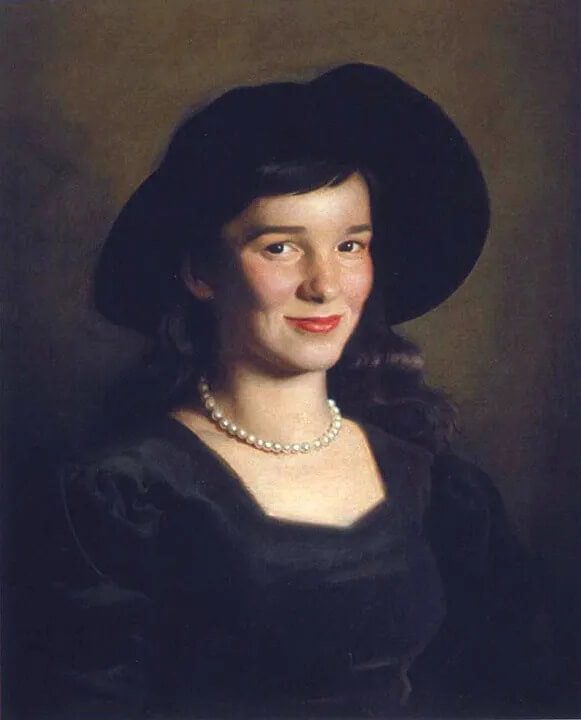
The Italian Hat by Richard Lack, 1955
LITERARY REALISM & REALISM (PAINTING)
In the early 19th century, artists all over the world rejected the academic stigma of the Age of Enlightenment and decided to sensationalize their works; this period is known as the romanticism movement (~1800-1850). But by 1850, the pendulum had swung back in the other direction, with artists seeking to return to the logician’s side.
Thus, literary realism and realism in painting was born. As with all other forms of realism, literary realism and realism in painting is truthful or “real” in intent. Here’s an excerpt from perhaps the most iconic “realist” novel of all-time — The Adventures of Huckleberry Finn.
The Adventures of Huckleberry Finn
“Well, when Tom and me got to the edge of the hilltop we looked away down into the village and could see three or four lights twinkling, where there was sick folks, maybe; and the stars over us was sparkling ever so fine; and down by the village was the river, a whole mile broad, and awful still and grand. We went down the hill and found Joe Harper and Ben Rogers, and two or three more of the boys, hid in the old tanyard. So we unhitched a skiff and pulled down the river two mile and a half, to the big scar on the hillside, and went ashore.”
THEATRICAL REALISM
Theatrical realism, obviously, belongs to live theater. But it was also something more than that: it was the staging ground for different types of realism, including naturalism, socialist realism, and psychological realism.
Naturalism is rooted in the French theater of the 19th century and is defined as simple performance art that seeks to create realistic depictions of society. Naturalism was also popular in Russian theater with writers like Leo Tolstoy and Anton Chekhov producing some of the most lauded realist works of all-time. This video from Course Hero breaks down Chekhov’s naturalistic The Cherry Orchard.
What is Realism in Film & Theater? • Course Hero Breaks Down The Cherry Orchard
About 20 years after The Cherry Orchard, the Russian arts movement moved on to a new type of realism: socialist realism; largely due to social upheaval and the development of the Russian film industry with Soviet Montage Theory.
HYPER REALISM IN FILM
The definition of hyper realism is loose – but most practitioners seem to agree that it’s “more than photorealism.” What is photorealism? Photorealism is the realistic recreation of an image through another medium, i.e, photo to painting. So, hyper realism is essentially the “more than real” recreation of an image through another medium; in this case film.
The 2014 film Birdman is a “good” example of hyper realism in film. Check out a trailer for the film below and think about why it might fall under the umbrella of hyper realism in film.
Hyper Realism in Film • Birdman Trailer
I’ll be honest: Birdman has a lot of surrealist elements. But then again, it’s definitely not naturalistic. Is it hyperrealistic? That’s up for debate. Ask a panel of experts and you’ll likely inspire a spirited debate.
PSYCHOLOGICAL REALISM IN FILM
Psychological realism in film differs from other types of realism in film in how it places the “realism” component of its narrative inside the character’s mind, so as to say that it doesn’t seek to recreate the external world through a collectively unconscious realist lens but rather through what the character interprets as real.
Psychological realism is largely associated with the works of Fyodor Dostoevsky, including Crime and Punishment, The Brothers Karamazov, and Notes From Underground.
Shutter Island – which is a novel written by Dennis Lehane and adapted to the cinema by writer Laeta Kalogridis and director Martin Scorsese – is a great example of psychological realism in film. This next video by Storytellers takes a look at how psychological realism plays a big role in Shutter Island.
Cinematic Realism • Shutter Island: Why Perspective is Everything by Storytellers
One could argue that the very concept of “reality” is subjective; something to consider when thinking about the question: what is realism in film?
UP NEXT
What is Surrealism?
Surrealism is pretty much the opposite of realism. In this next article, we explore how surrealism has been used by artists and filmmakers to communicate otherworldly themes in unforgettable ways. To get to the bottom of surrealism in film, we’ll look at examples from Salvador Dali, Federico Fellini, and David Lynch.
Up Next: Surrealism Definition and Examples →
The sitcom has been a staple of television for nearly 80 years. need a tight APP intro here that transitions to below..
Table of Contents
Everything you need to know about line producers.
- Chapter title...
- Chapter title
- Chapter title
- Chapter title...
- Chapter title..
- Chapter title...
- What is a producer?
- What does a producer do?
- The different types of producers
1
Line Producer Overview
A production leader
KEYWORD HERE...
Short, actionable h3 phrase...
Marshmallow pie sweet roll gummies candy icing. I love candy canes soufflé I love jelly beans biscuit. Marshmallow pie sweet roll gummies candy icing.
Caption goes here...
Caption goes here...
Related Posts
Sound Definition
what is diegeTic sound?
Non-diegetic sound is any sound that the viewing audience can hear but the characters in the scene cannot.
Non-Diegetic Sound examples in film: Underscoring such a the famous score from the shower scene of Hitchcock’s Psycho.
CASTING DIRECTOR DEFINITION
What does a casting director do?
A casting director is a person or team responsible for finding talent. They usually specialize in one particular area such as film, television, commercials, background, or theater. Their main purpose is to find the right talent for a particular project. Some casting directors receive producer credit for their work, especially when the names they bring to a project add considerable marquee value to the production.
Casting director job description and duties:
- Contact talent agencies and management companies, often through online casting platforms
- Schedule actors and hold auditions
- Provide insight, experience, and often draw from relationships with talent and reps
- Final casting decisions are usually made by producers, directors, and commercial clients
CASTING DIRECTOR DEFINITION
What does a casting director do?
A casting director is a person or team responsible for finding talent. They usually specialize in one particular area such as film, television, commercials, background, or theater. Their main purpose is to find the right talent for a particular project. Some casting directors receive producer credit for their work, especially when the names they bring to a project add considerable marquee value to the production.
Free downloadable bonus
Download FREE Cinematography Techniques Cheatsheet
This article took 30 hours to write. Thirty! Needless to say, there was a LOT we couldn’t include in the post. Download our FREE, printable cheatsheet PDF to get access to over 30+ cinematography tips (includes bonus content not in the post).

UP NEXT
Highly Related Article Title…
I love candy canes soufflé I love jelly beans biscuit.
Click to view the shot list
New Block - Download Free Scripts (PDF)
"The Switch"
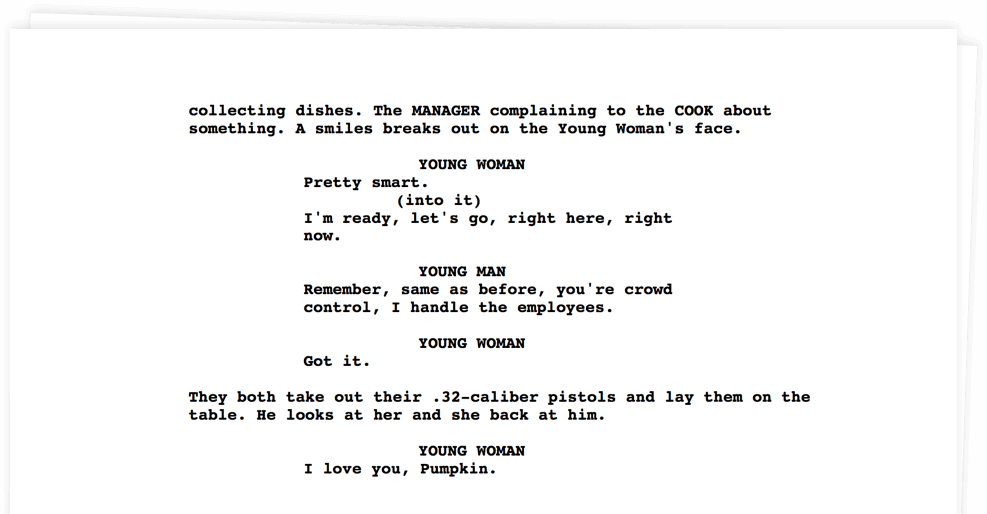
Download your FREE Pulp Fiction script (PDF).
Just enter your email address and we'll instantly send it to you!
Showcase your vision with elegant shot lists and storyboards.
Create robust and customizable shot lists. Upload images to make storyboards and slideshows.
